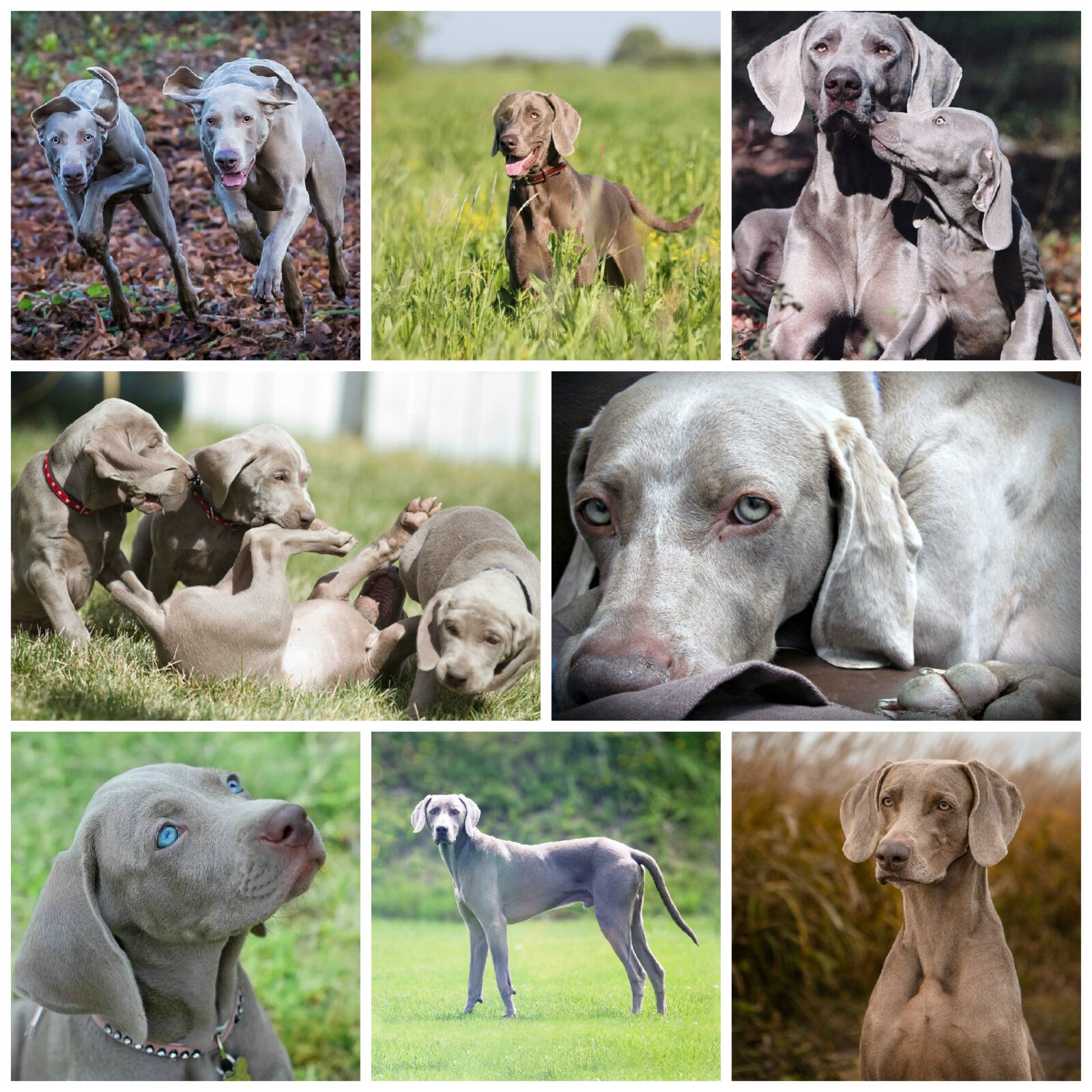Weimaraners (otherwise Weimar cops) - hunting gun dogs originally from Germany. In their hunting group, they belong to the continental cops, with equally well-developed upper and lower flair, which makes them valuable and prey hunters. The upper flair allows the Weimaraners to search for game by smell (almost regardless of the strength of the wind), the lower one - by the tracks. Weimaraners are also looking for wounded prey on a bloody trail. The owners-hunters appreciate the Weimar cops for their reliability, well-developed sense of smell and devotion. Most often, these dogs are used in the extraction of wild birds (snipe, corncrake, duck, partridge, quail) and animals (hare, fox). But these dogs have gained respect in other fields - they can become excellent searchers, as well as companions. Loyal, loving in return for a kind and sincere attitude, with a stable psyche, Weimaraners are almost universal dogs that do not require special care. In our country, many people are unaware of such a breed, although Weimaraners have long been respected and loved in hunting circles. It can be said that Weimar Pointers are excellent dogs for active families, as they are kind, agile and cheerful.

Brief description of the Weimaraner breed
Weimaraners - enough large dogs (their height is 60-70 cm, weight - 25-40 kg) with well-developed bones and muscles. The coat of dogs of this breed can be of two varieties - long or short. The long coat of the Weimaraner is soft to the touch, with a faint undercoat, feathering is present on the ears, chest, belly and tail of the dogs. Short-haired Weimaraners have fairly thick hair, shiny, close to the body, without a noticeable undercoat. But there is also a mixed type of wool - thick hair of medium length with moderate feathering. Weimaraner coat color is always gray - from silvery-pale to dark. On the head and ears of this dog breeds the coat is somewhat paler than on the entire body (a stripe of a dark gray shade may be present on the back, small marks of white in the area of \u200b\u200bthe legs and chest are acceptable). The head of the Weimar Hounds is dry, with a pronounced furrow along the non-convex forehead, the zygomatic arches are clearly visible, and the muzzle is long. The eyes are round in shape, light or dark amber in color (blue in puppies). The back of the nose is slightly convex, the lobe is large, brown-gray. Ears are always hanging, wide, set high, directed forward. The Weimaraner's neck is lean and muscular, broad at the base, merging into a proudly towering withers. The chest is wide enough. The back of the Weimaraner is characterized by stretching, a slope is noticeable in the croup area. The tail is pointing down at rest. The limbs of the Weimaraner are bony, with well-developed muscles, straight.
basic information
| Breed name: | weimaraner |
| Country of origin: | Germany |
| The time of the birth of the breed: | 19th century |
| Type of: | cops |
| The weight: | 25 – 40 kg |
| Height (height at the withers): | 60 - 70 cm |
| Life Expectancy: | 10 – 12 years old |
|
ICF classification:
|
Group 7, Section 1.1, Number 99 |
| Puppies price: | 200 – 500 $ |
| Most popular nicknames: | list of nicknames for the weimaraner |
Evaluation of the characteristics of the Weimaraner breed
| Adaptability
(a definition meaning how easily a dog can adapt to changes in life) |
🐶🐶🐶🐶🐶 |
| Shedding level
(Level and frequency of hair loss in the animal) |
🐶🐶🐶 |
| Tenderness level
(The level and amount of tenderness and affection that the dog gives in return for attention to itself) |
🐶🐶🐶🐶🐶 |
| Exercise needs
(Dog's daytime activity level) |
🐶🐶🐶🐶🐶 |
| Social need
(The required number of contacts of the dog with other animals, as well as people) |
🐶🐶🐶🐶🐶 |
| Apartment content
(A factor that determines the level of noise and other inconveniences that a dog can deliver to owners in relation to the size of the apartment to the size of the dog) |
🐶 |
| Grooming
(The number of bathing, brushing, and the number of professional grooming sessions required for the dog) |
🐶 |
| Friendliness in an unfamiliar environment
(Features of the behavior of a dog in a society with strangers or in an unfamiliar environment) |
🐶🐶🐶🐶🐶 |
| Tendency to bark
(Tendency to bark and its frequency and volume) |
🐶🐶🐶 |
| Health issues
(Potential health status of the dog) |
🐶 |
| Territoriality
(The dog's tendency to protect his home, yard, or even his owner's car) |
🐶🐶🐶 |
| Friendliness to cats
(The tendency towards tolerance for cats and decreased manifestation of hunting instincts) |
🐶🐶🐶🐶🐶 |
| Intelligence
(The ability of the dog to think and solve emerging difficulties (not to be confused with learning!) |
🐶🐶🐶🐶🐶 |
| Education and training
(The level of difficulty in training the dog to perform certain actions) |
🐶🐶🐶🐶🐶 |
| Friendliness to children
(A factor that determines how friendly a dog is to children, whether he likes to play with them and tolerate some childish pranks) |
🐶🐶🐶🐶🐶 |
| Game activity
(The concept is determined by its very name, and, as a rule, is found in almost all dogs) |
🐶🐶🐶🐶🐶 |
| Observation
(The ability of a dog to detect the presence of a stranger on its territory) |
🐶🐶🐶 |
| Friendliness to other dogs
(The tendency of the dog to find common language with his other relatives) |
🐶🐶🐶🐶🐶 |
Weimaraner photo:

History of the origin of the Weimaraner breed
The nature of the Weimaraner breed
Maintenance and care
Weimaraners require long walks 2 or 3 times a day. Moreover, dog walks should be not only long, but also interesting. simple walking - not the best way to spend time with a Weimaraner. It's great if the owner has the opportunity to train the dog in such disciplines as frisbee or agility. A long stay in the camps of an apartment is not at all suitable for the Weimar cops, since the passion for will is in their blood. By the way, these dogs do not tolerate living separately from the owner, so it is better not to settle the Weimaraner in enclosures and booths without access to housing. A dog that lives in the yard and rarely communicates with the owner can become lethargic and naughty. Aggressive Weimaraners are extremely rare, therefore, as guards of housing and lives, they are usually not turned on. Although, if necessary, Weimaraners can stand up for themselves and for their adored owner.
In terms of care, the Weimar cops are absolutely unpretentious. Their coat only requires brushing every week. Bathing of the Weimaraner is carried out 2-3 times a year, and after walking, the owner should only wipe the dog's paws. Be sure to clean the ears of the Weimaraner (weekly), monitor the hygiene of the mouth (brush the teeth every day), trim the claws (twice a month). As food, you can choose natural food or ready-made dry food. But you should not buy economy-class food, because they will only harm the health of the dog. It is not necessary to feed the animal with food from the table, since fatty, sweet, flavored with spices and seasonings food will not do any good.
Training and education
Puppy from the first days of the appearance in the house must go through the process of socialization. Do not hide it from all people and dogs. The animal must be accustomed to the sounds of the city, to the behavior of other pets in the house (if any). At a young age, the Weimaraner needs to be taught to wear a collar, putting it on a puppy every day for a while. If the Weimaraner will participate in the hunt, then some skills may be learned by him already at an early age.
Weimaraners respond well to training if the owner teaches them good behavior from an early age. To successfully master the commands of the Weimaraner, you should not overload and punish excessively. If a dog is acquired as a companion, then the completed General training course will be able to make a well-mannered and obedient friend out of the animal. The hunting dog must accompany the owner from the moment of 4-5 months during outings into nature. The training of Weimaraner hunters takes place from childhood, so that the dog learns all the subtleties of hunting. In cases where the owner of the Weimaraner does not plan to participate in hunting with the dog, sufficient loads should be selected in terms of any dog sport.
Health and disease
Some interesting facts
- Weimaraners are called silver ghosts. Such a mystical and mysterious nickname for dogs of this breed is fully justified. - one has only to look into their eyes, full of mystery and wisdom. A permanent coat color - from light - to deep gray really makes these amazing animals, as if woven from threads of precious metal.
- In the film "Handsome Alfie, or what men want" with actor Jude Law, a Weimaraner dog was filmed.
Nurseries and breeders
We borrowed material from the wonderful site of our partners DOGCATFAN.COM about cats and dogs, the author dogcatfan
